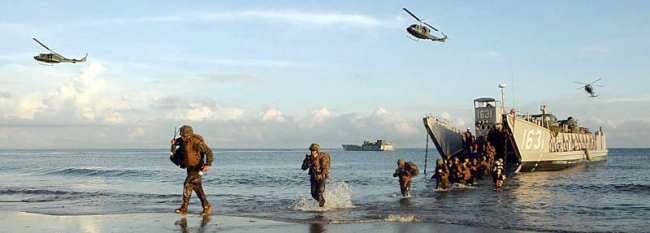WASHINGTON, April 6, 2010 — The Nuclear Posture Review, released today, is the first overarching look at U.S. nuclear strategy since the end of the Cold War, a senior defense official briefing reporters on background said yesterday. The review builds on President Barack Obama’s promise to take concrete steps toward the goal of achieving the safety and security of a world free of nuclear weapons, the official said.
A second element, the official added, was to maintain a nuclear deterrent as long as those weapons remain, and ensuring the safety, security and effectiveness of that deterrent while they remain.
The Nuclear Posture Review provides the basis behind many moves in the nuclear arena in the coming months, the official said. Obama will travel to Prague to sign the new strategic arms reduction treaty with Russia on April 8. The treaty mandates further reductions to the U.S. and Russian arsenals, and officials looked to the Nuclear Posture Review guidance as they negotiated the treaty.
The review also will influence U.S. thinking in the nonproliferation treaty, the nuclear security summit and the nonproliferation review conference.
The review is a “concrete, pragmatic work plan for moving forward this agenda,” the official said.
Congress mandated the review, and it is the third since the end of the Cold War. The Clinton administration conducted the first review in 1994, and the Bush administration the second in 2001. The scope of the review is broader than in the past, officials said.
That scope includes the roles of missile defense, conventional strike, force levels, the weapons complex and the role of arms control in shaping U.S. nuclear posture, the senior official said.
Specifically, Congress asked officials to look at seven elements pertaining to the role of nuclear forces in U.S. military strategy, planning and programming. They looked at how the United States would maintain a safe, reliable and credible nuclear deterrence posture, as well as the relationship among U.S. nuclear deterrence policy, targeting strategy and arms control objectives.
Officials also examined the role missile defense and conventional strike capabilities play in determining roles and sizes of nuclear forces. They looked at the levels and composition of nuclear delivery systems and what the nuclear complex required. Finally, officials studied the nuclear stockpile required to implement U.S. strategy.
Senior officials said the current review is Defense Department-led, but has strong interagency participation. Officials worked with international partners, the State Department, the Energy Department and various U.S. government agencies.
The review had intense scrutiny at the highest level of the government.
“It’s shorthand in the nuclear business that nuclear weapons are the president’s weapons,” the official said. Obama has been directly engaged in the process in a deliberative and thoughtful way, he added.
The key objectives of U.S. nuclear policy are to prevent nuclear proliferation and nuclear terrorism, the official said, and the government also wants to reduce the role and numbers of nuclear weapons. An objective, the official added, is to maintain effective deterrence with fewer weapons.
Another objective, he said, is to strengthen regional deterrence and reassurance of U.S. allies and partners. The United States provides a nuclear umbrella for NATO allies, Japan and South Korea, for example, and the review looks at changes in those relationships.
Source:
U.S. Department of Defense
Office of the Assistant Secretary of Defense (Public Affairs)

 von
von 